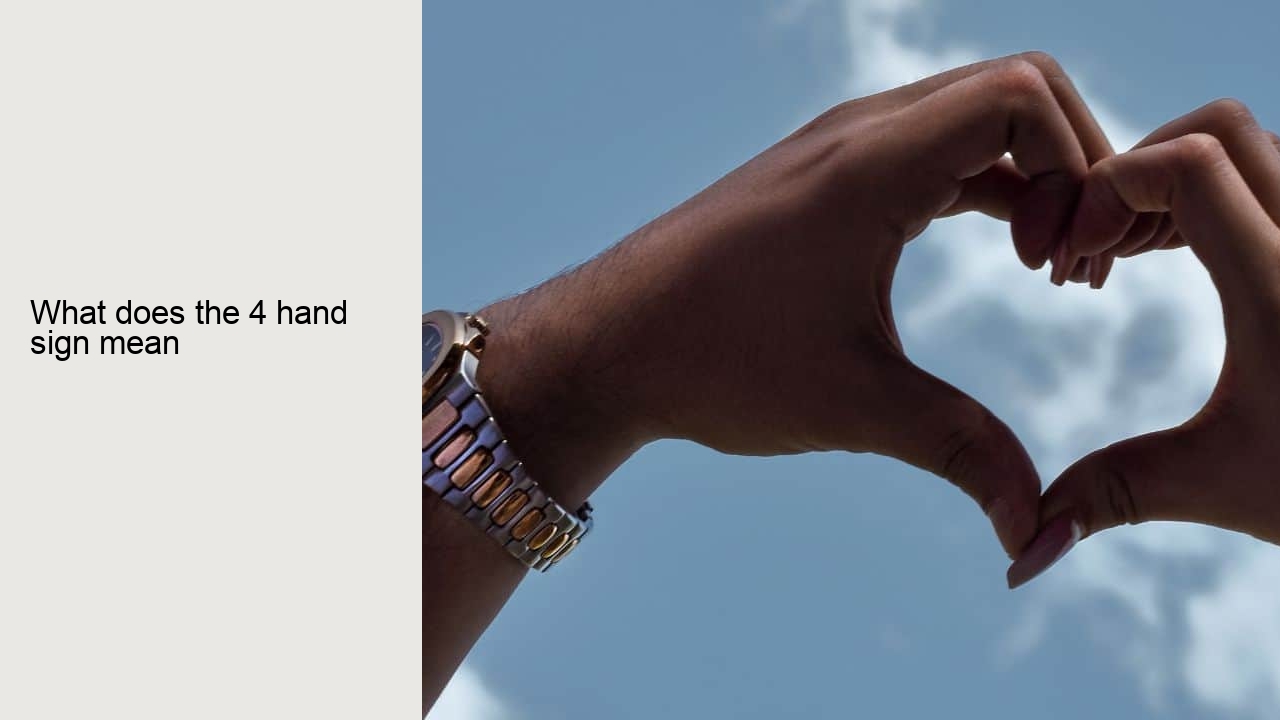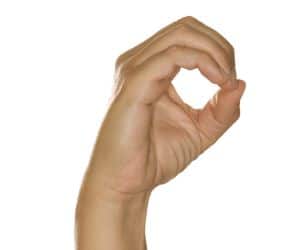
The origins of this sign are shrouded in mystery and speculation, with some historians suggesting that it may have its roots in ancient pagan rituals, while others point to its presence in medieval grimoires and occult texts. Some scholars have even proposed that the sign is a remnant of a long-forgotten spiritual tradition that predates recorded history.
Despite its enigmatic origins, the four hand sign continues to be popular among those who practice the occult and esotericism, and is often seen as a powerful symbol of protection, strength and spiritual power.
The "I Love You" gesture is made by holding up the thumb, index finger and little finger in the shape of an "I" while the middle and ring fingers are tucked under the thumb. This gesture is used to express love, affection, and support.
The "talk to the hand" gesture, made by holding up the hand in front of the face, palm facing outwards, is used to indicate that the person does not want to listen or engage in further communication. This gesture is often used to dismiss or reject an idea or person.

The "stop" gesture is made by holding the hand up with the palm facing out, and moving the fingers in a stopping motion. This gesture is used to indicate that you want someone to stop doing something or to indicate that something should stop. This gesture is often used in situations where you want to indicate that an action or activity should be halted.
On the other hand, the thumbs down is often used to indicate disapproval or rejection. This gesture is similar to the thumbs up but is made by turning the hand upside down.
In conclusion, hand signs and gestures are an integral part of teen communication and convey a wide range of meanings, both positive and negative. From simple hand signals like the peace sign to more complex gang signs, teens use hand gestures to express themselves and connect with others. It is important to be aware of the meanings behind these signs and to educate oneself about the positive and negative aspects of these hand gestures, so that they can be understood and used appropriately.
The "OK" hand gesture is another widely recognized hand gesture. It is generally used to indicate that everything is alright, or to ask if everything is alright. The gesture is made by connecting the thumb and index finger in a circle, with the other three fingers extended. It is a simple yet effective gesture that can be used in a variety of contexts, from casual conversations to more formal business meetings.
The "shh" sign is made by placing the index finger over the lips. This gesture is used to indicate silence or to ask someone to be quiet.
Hand signs, also known as hand gestures, are a rich and nuanced form of nonverbal communication, conveying meaning through the movement and positioning of the hands. From simple signals like the thumb's up to more complex body language cues, hand signs can express a wide range of emotions, ideas, and intentions. In this article, we will explore the meanings, origins, and cultural significance of some of the most common and important hand signs, delving into the subtle nuances of this fascinating aspect of human communication.

In conclusion, hand signs are an intricate and nuanced form of nonverbal communication. From the thumb's up to the "I love you" gesture, they can express a wide range of emotions, ideas, and intentions. Understanding the meaning and significance of different hand signs can help us communicate more effectively and build stronger connections with others.
The fist bump is a casual gesture of greeting or agreement, made by touching the knuckles of one's fist against another person's fist. This gesture is thought to have originated in the African American community, and it is often associated with sports and hip-hop culture.
One of the most popular hand signs among teens is the "peace sign," which is made by holding up the index and middle fingers in the shape of a "V." This gesture, which originated in the 1960s as a symbol of anti-war sentiment, is often used among teens to indicate peace, friendship, or to make a peace sign.
Another commonly used hand sign is the peace sign, made by holding up the index and middle fingers in the shape of a "V". This gesture has its roots in the counterculture of the 1960s, and is often associated with feelings of peace, love, and unity. In some cultures, it is also used as a way of saying "victory" or "good luck".
The "gang sign" hand sign, which is made by holding up the thumb and index finger while keeping the other fingers curled down, is often used among teens to indicate gang affiliation, or as a sign of aggression or violence.
Another common hand gesture is the peace sign, which is made by holding up the index and middle fingers in a V shape. This gesture has its roots in the counterculture of the 1960s, and it is often used to express feelings of peace, love, and unity. In some cultures, it is also used as a way of saying "victory" or "good luck".
Holding two fingers down can hold different meanings depending on the context and culture. In some sports, it is a sign of a referral to the video assistant referee. Additionally, it can be used as a symbol of disapproval or rejection, opposite to holding up two fingers which can be considered as a symbol of peace and goodwill. It can also be used as a sign of disappointment or defeat. As with any hand gesture, the meaning can vary and it's important to be aware of the context and cultural implications before using this gesture. It's important to note that in certain cultures, it might not have a specific meaning, and it's best to be cautious and respectful when using any hand gestures.
Holding two fingers down can hold different meanings depending on the context and culture. In some sports, it is a sign of a referral to the video assistant referee. Additionally, it can be used as a symbol of disapproval or rejection, opposite to holding up two fingers which can be considered as a symbol of peace and goodwill. It can also be used as a sign of disappointment or defeat. As with any hand gesture, the meaning can vary and it's important to be aware of the context and cultural implications before using this gesture. It's important to note that in certain cultures, it might not have a specific meaning, and it's best to be cautious and respectful when using any hand gestures.
Holding up two fingers can hold different meanings depending on the context and culture. In some countries like the United Kingdom, it's a symbol of peace and goodwill and also known as "V for Victory" sign. In other countries, it can be considered as an offensive gesture. In American Sign Language, it represents the number two. Also, in some sports, it's a sign of a referral to the video assistant referee. Additionally, it's also used as a symbol of binary opposition, such as good and evil, life and death, and so on. The meaning can vary, and it's important to be aware of the context and cultural implications before using this gesture.
Holding up four fingers in pictures is a symbol of solidarity and unity among athletes. It is often used to represent the "four pillars" of sportsmanship: physical, mental, emotional, and spiritual. By holding up four fingers, athletes are expressing that they are not just strong in their physical abilities, but also in their mental and emotional fortitude, and their spiritual dedication to their sport. This gesture is a reminder that true success in athletics is not just about winning, but about the holistic development of the individual.
Holding up one finger can hold different meanings depending on the context and culture. In American Sign Language, it represents the number one. In some sports, it's a sign of a referral to the video assistant referee. Additionally, it can be used as a symbol of singularity or unity, as in the phrase "one for all, and all for one." On the other hand, it can also be considered as an offensive gesture in some cultures, as it can be interpreted as an expression of dominance or superiority. As with any hand gesture, the meaning can vary and it's important to be aware of the context and cultural implications before using this gesture.